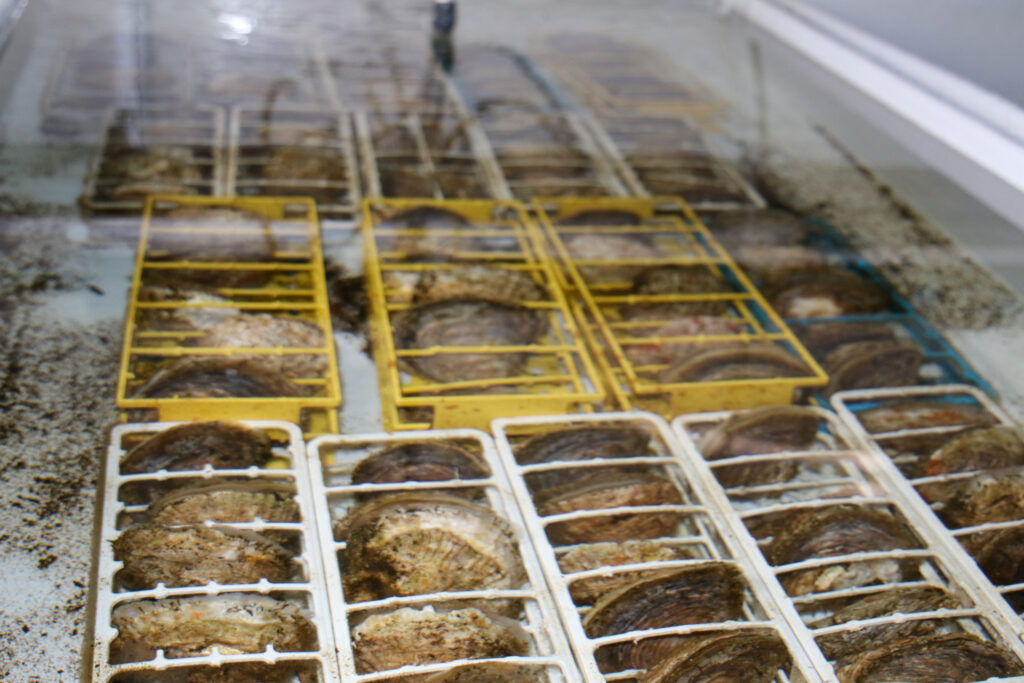
As a marine conservation organisation, there is so much we’ve been able to learn from previous restoration projects. Over the last few decades, scientists and researchers have made steps towards the goal of restoring the 85% of oyster reefs lost globally.
While some projects have been successful, others have struggled to thrive in the long term.
The key to oyster reef restoration lies in a method that promotes growth and self-sustainability over the years.
To optimise how oyster restoration can be done, we’ve looked into what worked so far and what didn’t succeed and conducted laboratory and field testing.
After two years of dedicated work, we’ve identified these are the key factors to optimise oyster restoration.

Merely bringing oysters from a hatchery into the sea is not a viable option. First of all, it should be a site where oyster reefs previously existed, ensuring conditions are favourable for long-term survival.
We undertook desk research to compile a list of key criteria for the European Native oysters and used it to evaluate each site where we consider restoring an oyster reef. These factors include water characteristics, salinity, oxygen levels, nutrient levels, temperature, currents, the biodiversity of the area, possible predators, and existing infrastructures among others.
We also need to take into consideration the existing environmental policies of each site, to adapt and act accordingly to what is necessary for that area.
Restoration projects are often deployed offshore where there is existing infrastructure and logistics, for example around wind farms. The costs of working offshore are higher than those of working in coastal locations, and sedimentation is a risk in this rough conditions, with the potential to lose the reef.
The critical mass, representing the density and number of oysters required for ecosystem takeoff, is a crucial but often overlooked aspect. Restoring oyster reefs of thousands of oysters may not lead to self-sustaining oyster reefs. Threats such as predators, storms, or diseases can significantly diminish the oyster population. A smaller oyster population not only reduces the reproduction rate but also limits genetic diversity, hindering the emergence of more resistant individuals within the population.
We only deploy oyster reefs with a minimum of 4 million oysters, as that is what we consider a safe critical mass for the reef to thrive.
Cost limitations often restrict oyster restoration projects to small scales, as they rely on philanthropy funds.
For a project to be successful, it needs to be scalable. Oyster Heaven created a model that brings financial scalability generating revenue from restoring oyster reefs, so that we can continue restoring the next reef, and so on. To learn more about our model, read this article.

The choice of substrate also often limits the scale of a project. While the ideal substrate for oysters to settle on is other oyster shells, we don’t have enough shells to restore the trillions of oysters that are gone.
That’s why it was key to create a substrate that can be produced in large quantities for a low cost, that is suitable for oysters and made of a natural material.
These criteria led us to create the Mother Reef, a structure made of clay that can be produced inexpensively by traditional brick factories anywhere in the world.

Mother Reef covered with oyster spats
We conducted extensive research to reach settlement rates as close as possible to those of settlement on oyster shells in a scalable way.
Oyster Heaven’s Research Specialist Dr Natacha Juste-Poinapen worked on the characterisation of the bacteria and archaea community associated with wild oysters and researched the role of oyster shell biofilms in oyster larvae settlement. The results confirmed that the Mother Reef is a suitable substrate for oyster restoration. A paper summarising these findings has been accepted for publication in the Open Access Marine Science Journal.
Our restoration method prioritises efficiency and cost-effectiveness, starting in controlled tank environments before deployment into the sea, ensuring a minimum of 50 baby oysters (spats) on the Mother Reefs.
Through research, experiments and tests, we are confident that we’ve found the most cost-effective way to restore large-scale oyster reefs, each with a minimum of 4 million oysters.

Make a measurable difference for the ocean today.
You can now adopt a Mother Reef and help restore 100 oysters!

